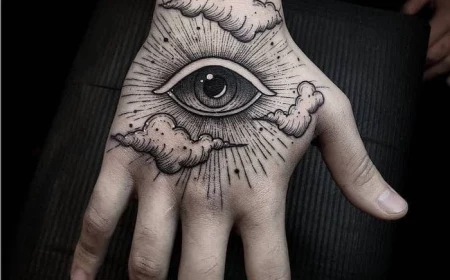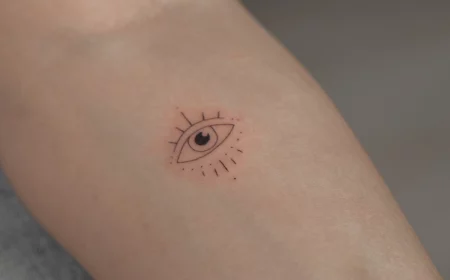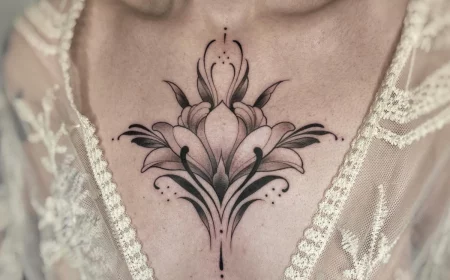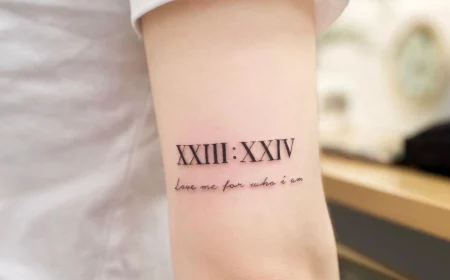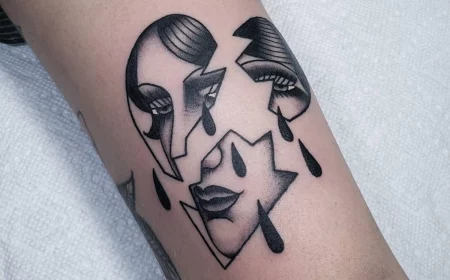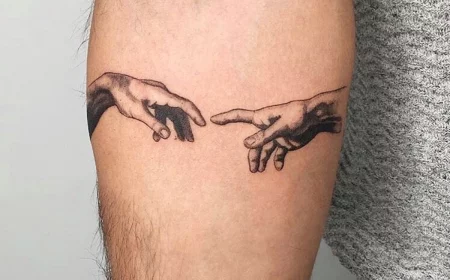Thinking About a Galaxy Tattoo? Read This First.
I’ve been slinging ink for over a decade and a half, and I’ve seen tattoo trends come and go. But galaxy tattoos? They’re not a trend; they’re a challenge, and they’re here to stay. I’ll never forget my first attempt. A young woman who studied the stars came in with these incredible, grainy images from a space observatory, pointing to a famous, pillar-like nebula. She wanted that cosmic cloud on her shoulder blade.
In this article
I was thrilled, but honestly, a little terrified. See, skin isn’t a flat canvas you can just paint on. It breathes, stretches, and has its own ideas about what it wants to do with ink. The real test was making those deep blues and vibrant purples look like they were glowing from within her skin, not just sitting on top like a sticker. It took two long sessions, lots of careful layering, and every trick I knew. Seeing it fully healed months later taught me the most important lesson about this style: a great galaxy tattoo isn’t about copying a picture. It’s about using light, color theory, and an intimate understanding of skin to create a living piece of the universe.
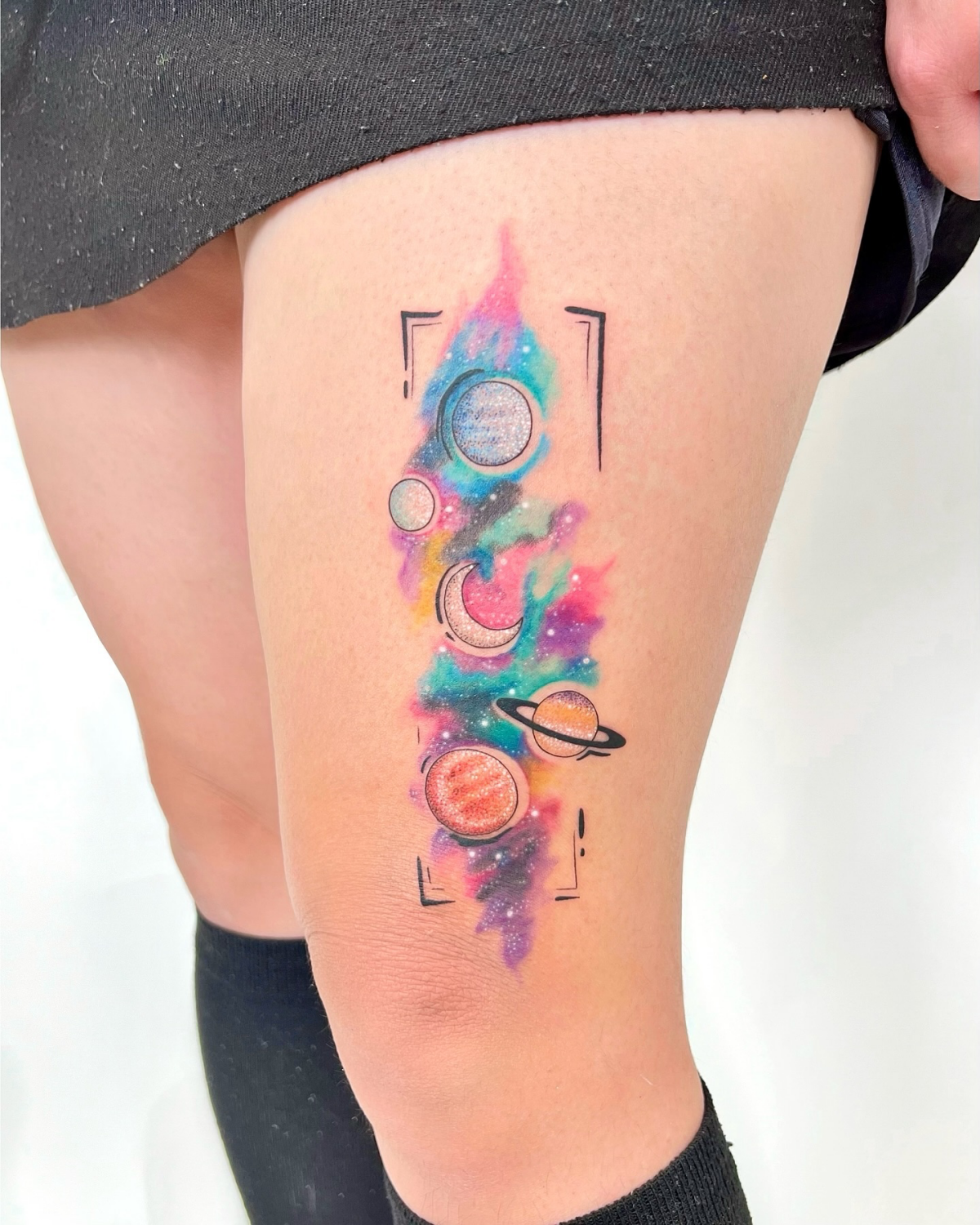
These tattoos are the ultimate technical test. Done right, they are breathtaking works of art that look incredible for a lifetime. Done wrong, they can turn into a muddy, faded bruise in just a few years. The difference is all in the planning and technique. So, if you’re thinking about getting one, let’s go beyond the pretty pictures and talk about what really makes a galaxy tattoo work.
It’s All About Light and Layers
To pull off a convincing galaxy tattoo, you have to think about how light actually works out there in space, and how ink is going to behave here on Earth, in skin. This is the foundation of a design that looks just as good in ten years as it does on day one.
A real nebula has incredible depth. Parts of it glow, energized by new stars. Other areas are just reflecting distant starlight, and some sections are just dark, dense clouds of dust blocking everything behind them. To get that effect, we have to layer ink in a very specific order. You can’t rush it.
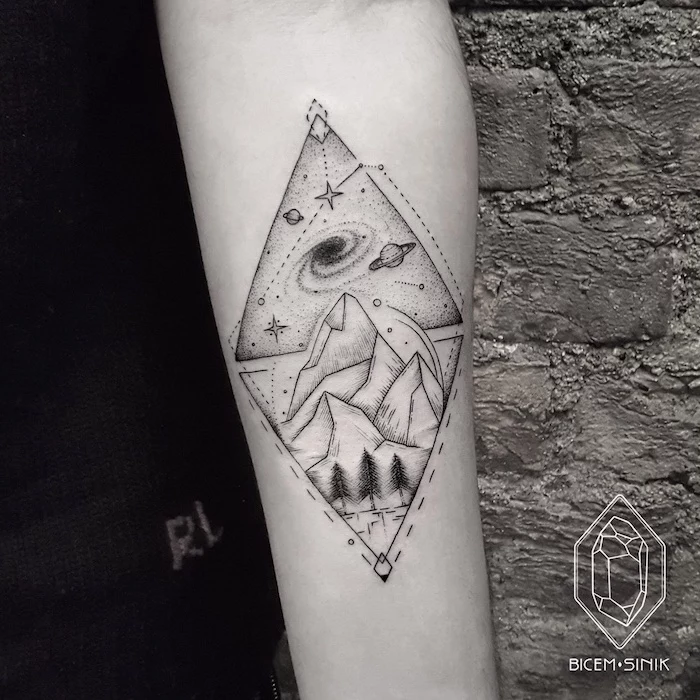
We always start with the darkest colors first—usually a mix of solid black and deep violet or midnight blue to map out the vastness of space. This sets the stage. Then, we work our way forward, layering lighter, more transparent colors on top. The pinks, teals, and oranges are applied over that darker base. This is what creates that soft, glowing look, because the dark ink underneath gives the bright colors dimension. If you just place bright colors next to each other, the whole thing will look flat. It’s a game of depth.
Working with Your Skin, Not Against It
Here’s a reality check: skin is not white paper. It has its own undertones—pinks, yellows, reds, golds, browns. A pro has to account for this. The color you see in the ink cap is never the final color you’ll see in the healed tattoo. Your own skin tone acts like a permanent filter over the ink.
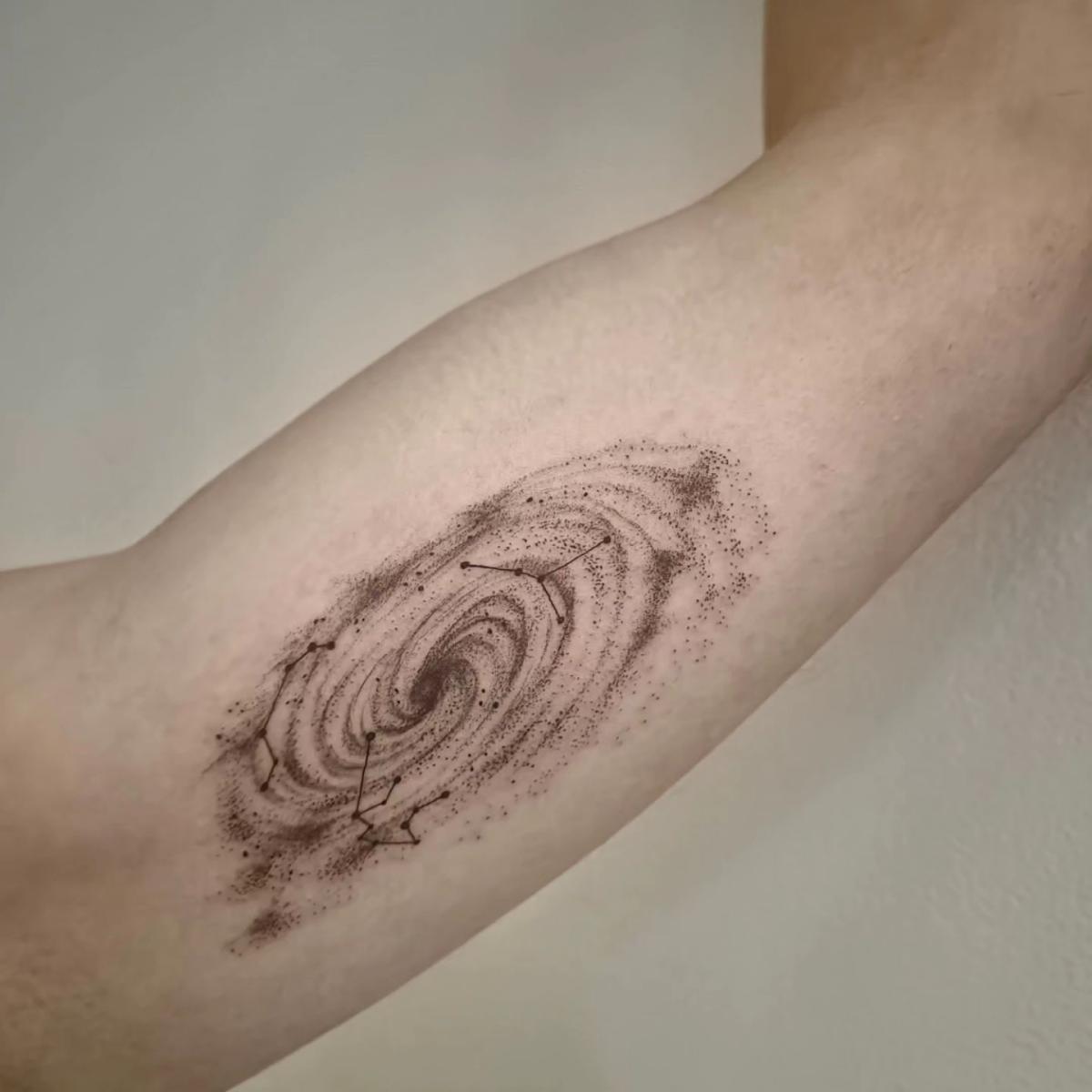
For someone with fair skin, we can use a wider palette of bright, punchy colors like light blues and yellows. On darker skin tones, the strategy changes completely. I lean heavily on contrast and color temperature. I’ll use rich magentas, deep teals, and vibrant purples that have the power to stand out. I also plan for more negative space (un-tattooed skin) to let the design breathe and create that crucial contrast. White ink is used very sparingly for those sharp star highlights, but it has to be done perfectly. On some darker skin, white can sometimes heal to a slightly yellowish or gray tint over time. Honestly, figuring this out just comes from years of experience and seeing my work heal on hundreds of different people.
The Pro Techniques That Make a Difference
The gap between an amateur and a professional galaxy tattoo is all in the technique. It’s about the specific tools we choose, how we put the ink in the skin, and having the patience to build the design correctly.
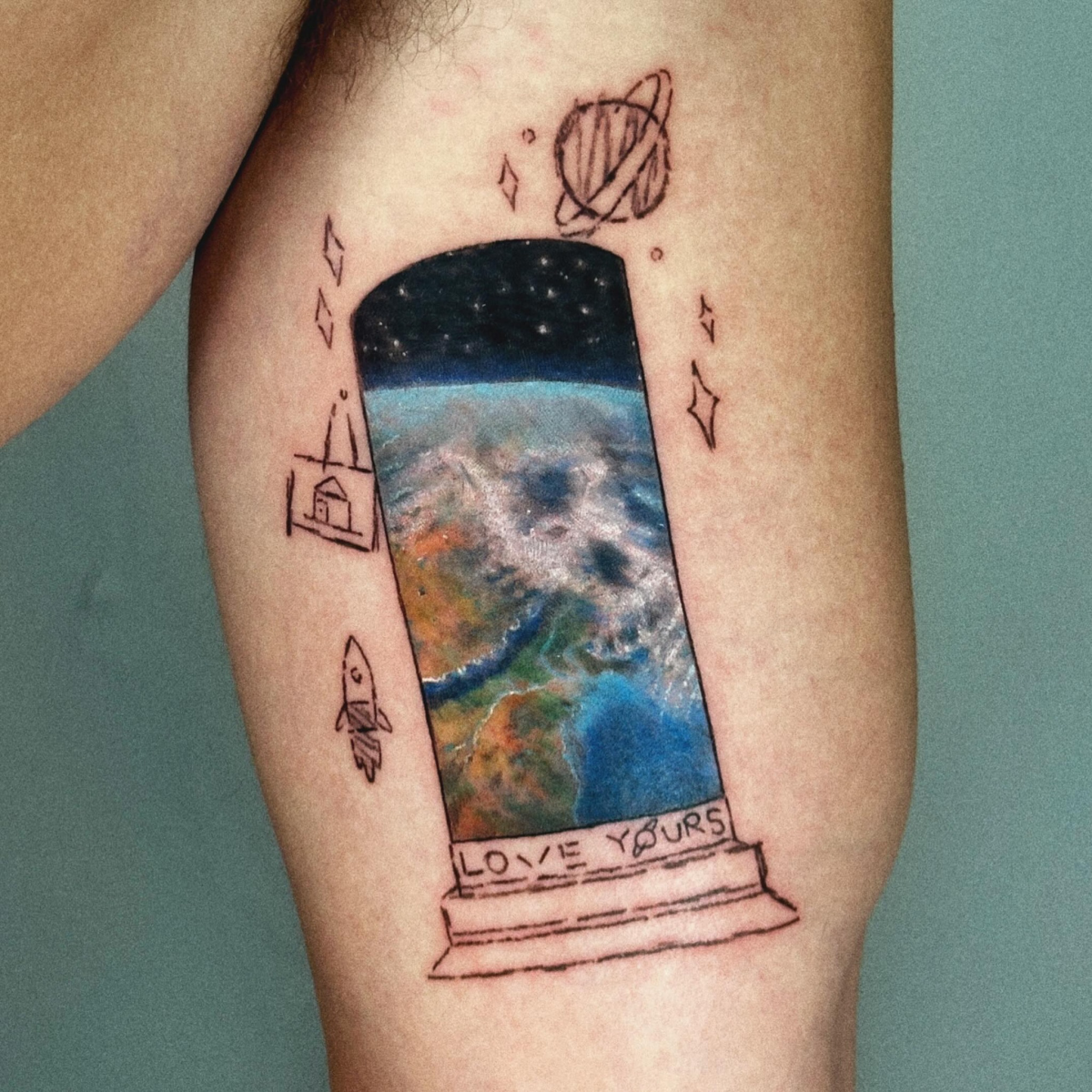
Tools of the Trade
For this kind of work, my setup is very specific. I almost always reach for a rotary tattoo machine. Its hit is gentler and more consistent, which is perfect for the smooth color blending galaxies demand. For creating those soft, cloudy fields of color, curved magnums are the hero. A 13 or 15-curved magnum lets me feather the edges of a color so you don’t get any harsh lines.
Then for the tiny, sharp stars, I’ll switch to a small round liner, maybe a 3RL. A quick tip: I just dip the very tip of the needle in white ink and use a quick flicking motion. This creates a perfect pinprick star. If you’re not careful, it’s easy to “blow out” the white, which creates a fuzzy, blurry spot under the skin instead of a crisp star.
What to Expect: The Layering Process
A big galaxy piece is a marathon, not a sprint. It’s almost always done over multiple sessions. Here’s a rough idea of how it usually goes down:
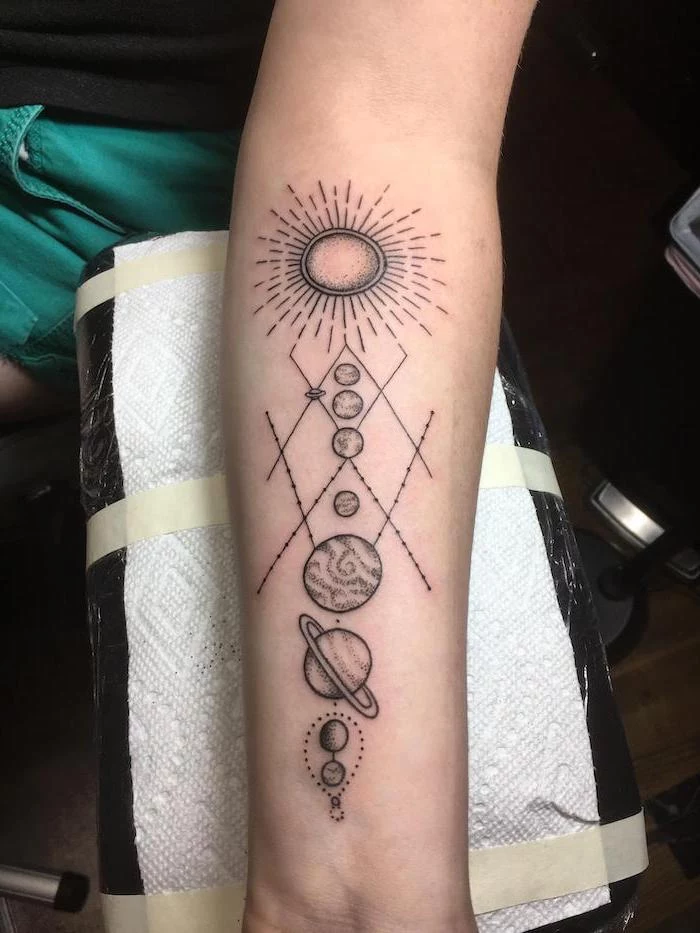
- Session 1: The Blueprint. The first sit is often just for the black and dark tones. We map out the overall flow of the design, making sure it wraps around the arm or back in a way that compliments the body’s shape. This needs to heal completely, usually for about 3-4 weeks, before we even think about color.
- Session 2: Bringing in the Color. Now the fun begins. We start layering the colors, working from dark to light and blending everything seamlessly. This is a delicate balance. Pushing the needle too hard damages the skin and leads to patchy healing; not going deep enough means the color will just fall out.
- Session 3 (and maybe 4): Details and Highlights. The final touches, like the bright centers of stars and those wispy, glowing gas effects, are done last. This is what makes the whole tattoo pop. But less is more—overdoing the white can ruin the whole illusion of depth.
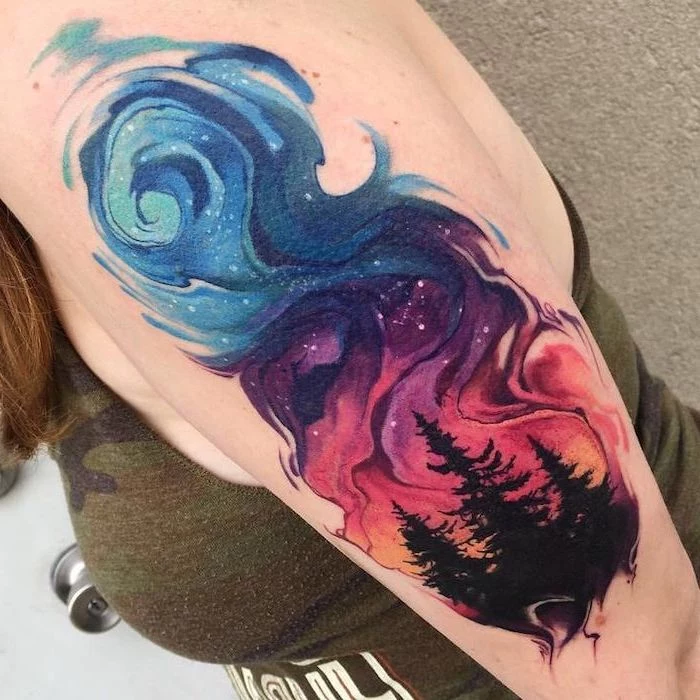
Finding the Right Artist (And Avoiding the Wrong One)
This is, without a doubt, the most important decision you’ll make. Please, do not choose an artist based on price. A cheap tattoo is rarely good, and a good tattoo is never cheap.
So, what should you look for?
A portfolio packed with vibrant, well-blended color tattoos is a must. But here’s the real test: ask to see photos of their work HEALED. Fresh tattoos are always red and swollen, which can hide a lot of mistakes. You want to see pictures of their tattoos that are at least a year old. Do the colors still pop? Are the blends still smooth? If an artist doesn’t have healed photos of their color work, that’s a huge red flag.
Speaking of Red Flags, Watch Out For These:
- They have zero healed photos of color tattoos. This is the big one. If they can’t show you how their work lasts, walk away.
- They say “yes” to a tiny, super-detailed galaxy. An experienced artist knows these tattoos need space to work. Trying to cram a nebula onto a finger or behind an ear is a recipe for a muddy blob down the line.
- They rush the consultation. A good artist will have a ton of questions for you. They’ll want to discuss placement, size, and your ideas. If they seem dismissive or don’t offer their own professional input, they don’t care about the result.
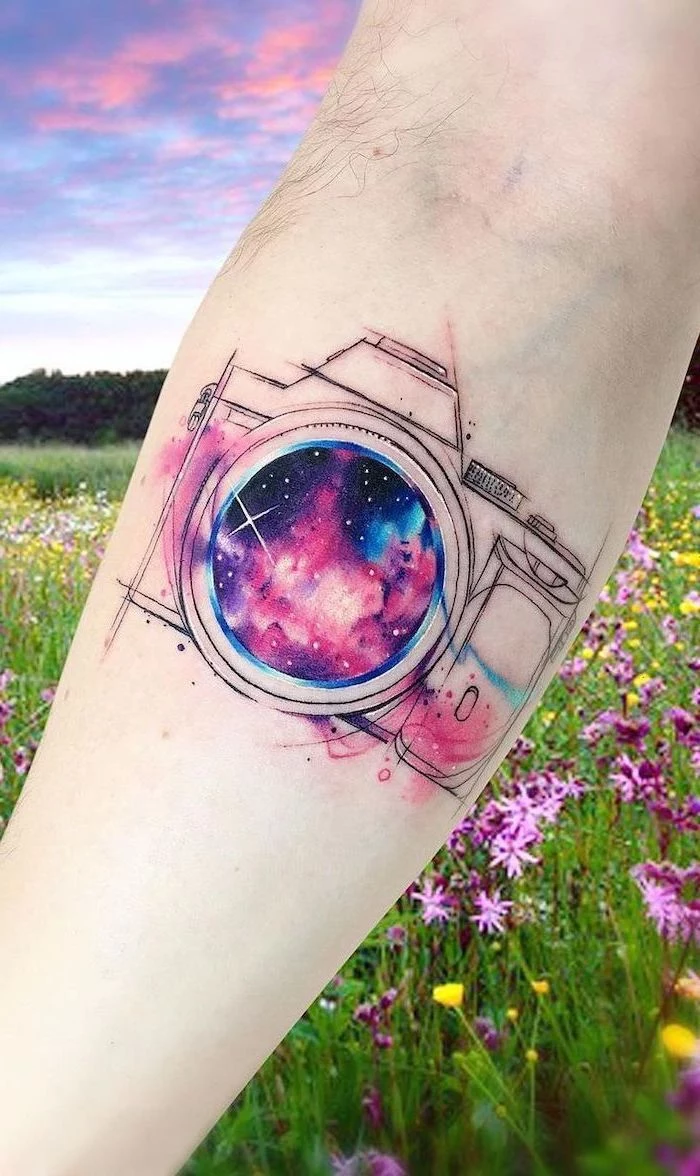
Let’s Talk Money: The Reality of the Cost
Alright, let’s get real about the investment. For an artist who truly specializes in this style, you should expect to pay anywhere from $150 to over $300 an hour. A full galaxy sleeve can easily take 30 to 50 hours of needle time, spread out over a year or more. You do the math. We’re talking about a project that could cost between $5,000 and $15,000, or even more.
It’s a serious financial commitment. Be prepared for that reality before you book your consultation.
Protecting Your Investment: Aftercare is Everything
You wouldn’t buy a sports car and then never change the oil, right? A tattoo is a medical procedure, and how you care for it afterward is critical.
Your Aftercare Shopping List
Good to know: you don’t need a bunch of expensive, fancy products. Keep it simple. Head to any pharmacy and grab these:
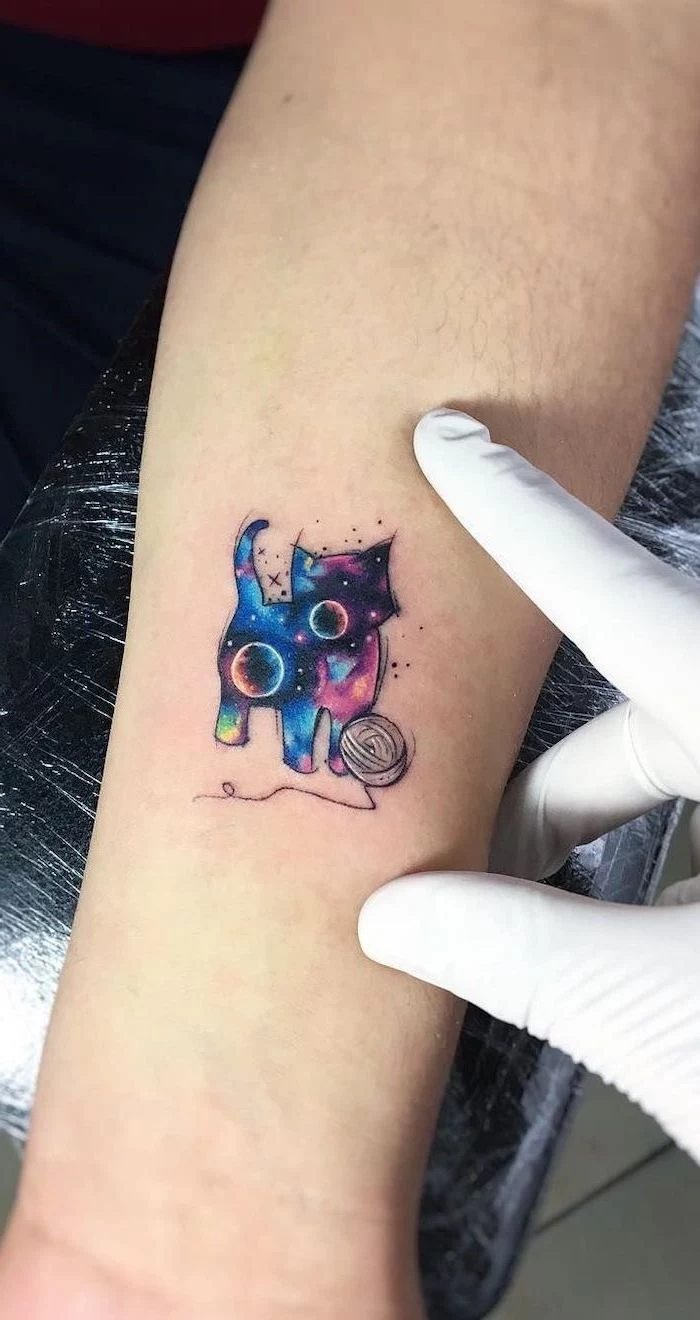
- A gentle, unscented antibacterial soap (like Dial Gold).
- A quality, unscented moisturizer (like Lubriderm, Cetaphil, or Aquaphor).
- Paper towels for patting it dry. That’s it.
The Day-by-Day Healing Guide
The healing process for a large color piece is intense. Here’s what to expect:
Days 1-3: It’s going to be sore, red, and might weep a bit. This is normal. Gently wash the tattoo two to three times a day with the antibacterial soap and lukewarm water. Pat it dry with a clean paper towel (don’t use a cloth towel, which can harbor bacteria). Apply a very, very thin layer of ointment.
Days 4-14: The itch is coming. As the tattoo starts to peel and flake like a sunburn, it will get incredibly itchy. DO NOT PICK OR SCRATCH. Let the flakes fall off on their own. During this phase, switch from the ointment to a thin layer of unscented lotion whenever it feels tight or dry.
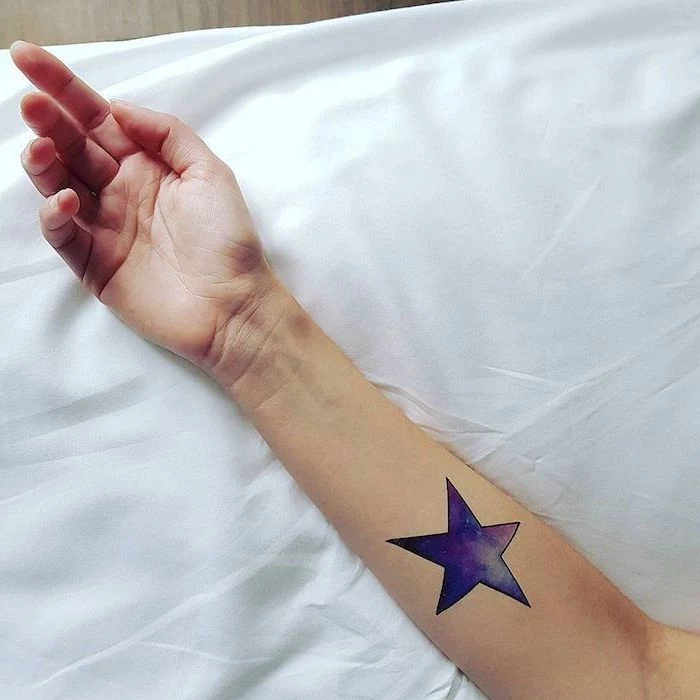
After about two to four weeks, the surface will be healed, but it can take a few months for the deeper layers of skin to fully settle. The colors might look a little dull or cloudy during this time—don’t panic! The vibrancy will return.
The #1 Enemy of Your Tattoo
Listen up, because this is the most important piece of long-term advice I can possibly give you: protect your tattoo from the sun. UV radiation breaks down ink pigment. It is the single biggest reason color tattoos fade. Those delicate light blues and pinks in your galaxy are especially vulnerable.
Once it’s fully healed, you must apply a high-SPF sunscreen every single time it’s going to be exposed. A quick tip from my experience: go for a mineral-based sunscreen (SPF 50+) with zinc oxide. It creates a physical block that’s much better at protecting the integrity of tattoo colors than a chemical sunscreen. A tattoo that’s shielded from the sun will look amazing for decades. One that isn’t can look like a washed-out mess in just a few years.
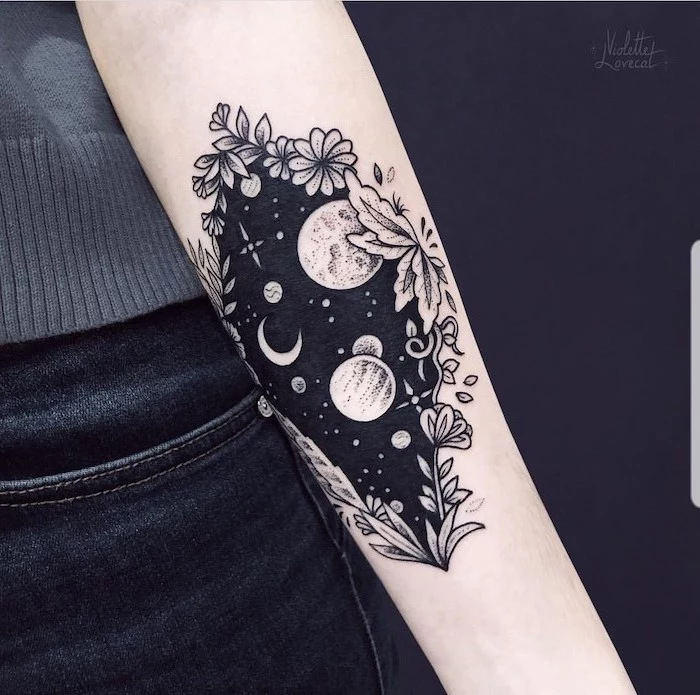
Quick Questions I Get All the Time
Does a color tattoo hurt more than black and grey?
It can, yeah. The process of packing in solid fields of color and blending them smoothly often requires the skin to be worked a bit more than simple linework or shading. Everyone’s pain tolerance is different, but be prepared for some long, intense sessions.
Can you add to it later?
Absolutely! That’s one of the great things about this style. A good artist can easily extend a nebula or blend new elements into an existing piece, making it feel like it was all planned from the start.
What if I have freckles or dark skin?
We work with it! We would never tattoo over moles, but freckles can be tattooed over and often just look like distant stars, which is a cool effect. As for darker skin tones, a skilled artist who understands color theory can create a stunning, vibrant galaxy tattoo by focusing on contrast and choosing the right color palette. Don’t let anyone tell you it can’t be done.
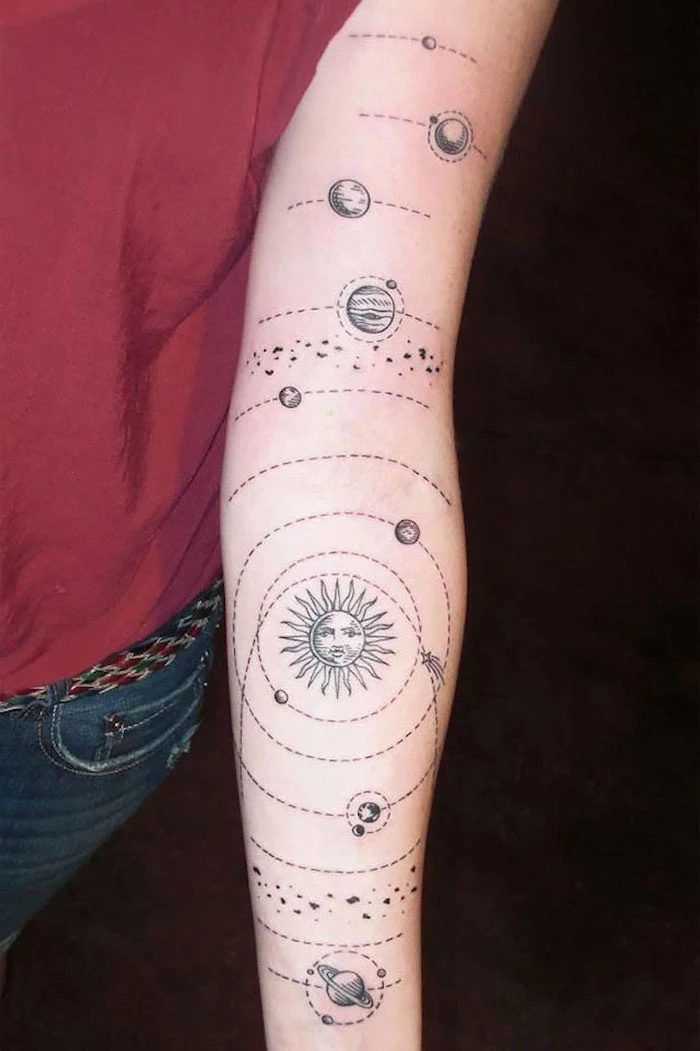
Inspirational Gallery
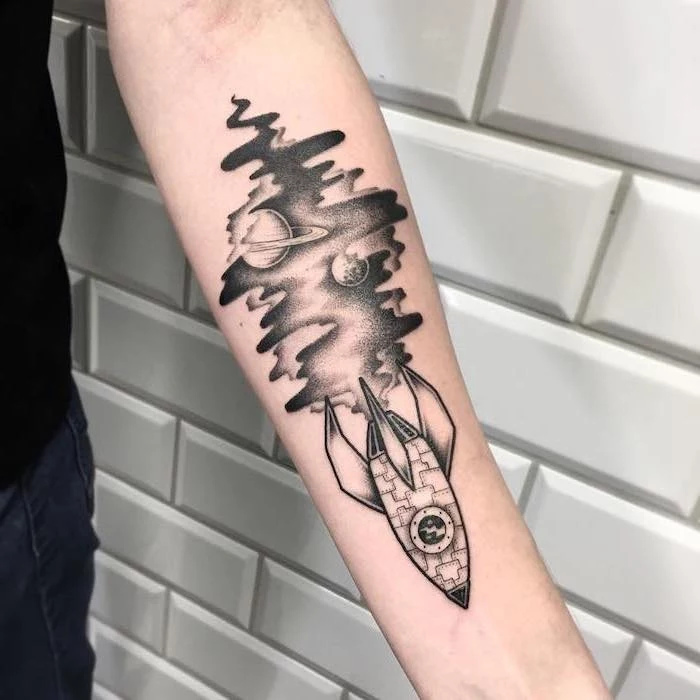
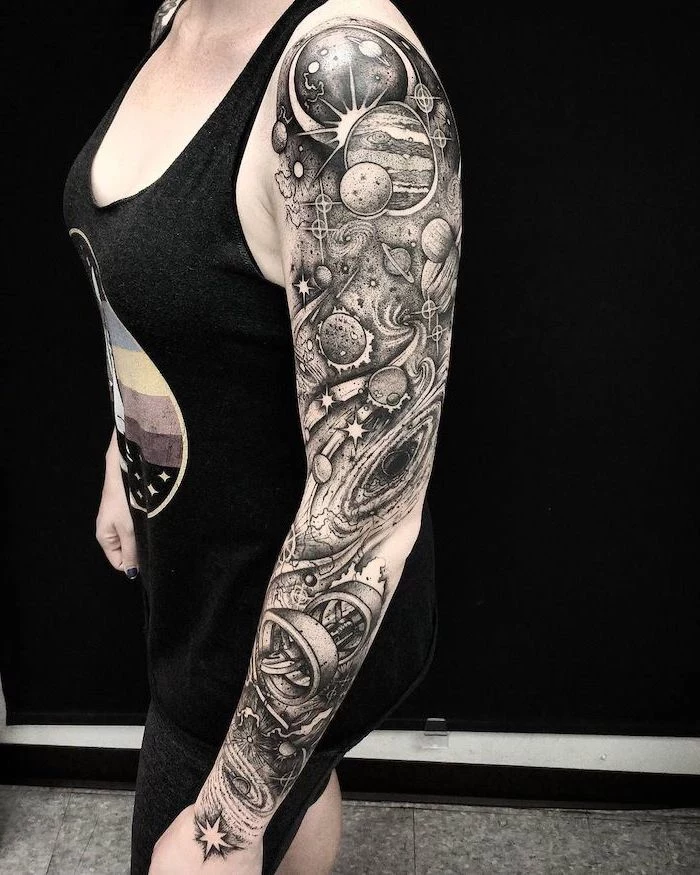
The Most Important Step: Healing. A galaxy tattoo’s brilliance depends on how you treat it in the first month. Many artists now recommend a ‘second skin’ bandage like Saniderm or Recovery Derm Shield for the first 3-5 days. This protects the heavily worked skin from bacteria and keeps it hydrated. Once removed, switch to a high-quality, unscented moisturizer like Lubriderm, or a dedicated tattoo butter like Hustle Butter Deluxe to keep those cosmic colors from drying out.
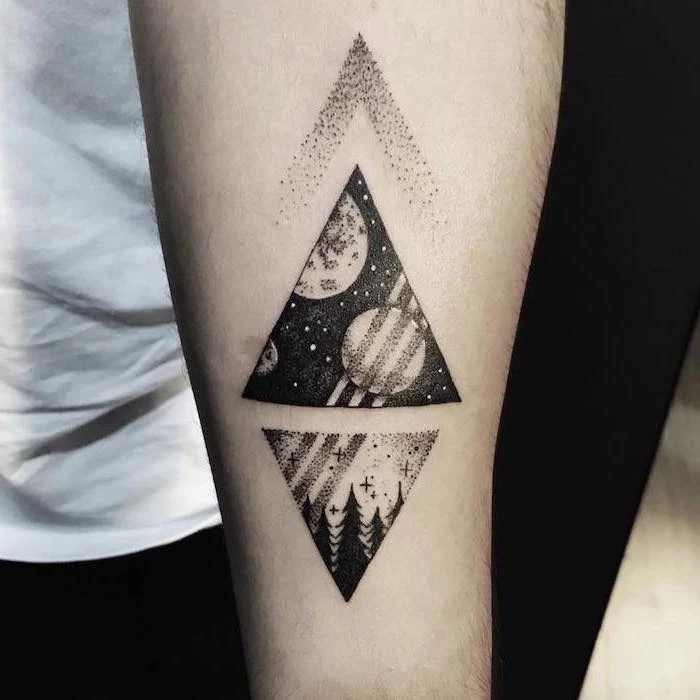
- A single, detailed planet like Saturn on the inner wrist.
- Your zodiac constellation in fine lines on the ankle.
- A tiny, minimalist rocket ship behind the ear.
- A crescent moon filled with a small patch of starry sky.
The secret? You don’t need a full sleeve to wear a piece of the cosmos.
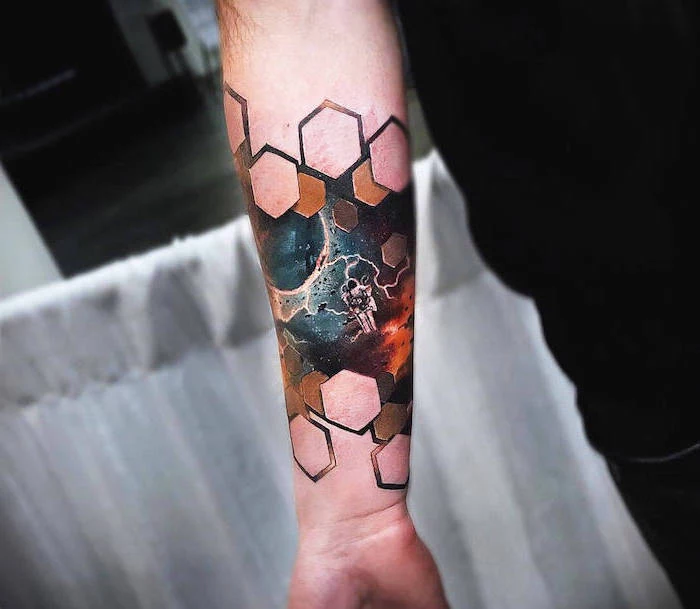
A single nebula can contain the mass of more than 100,000 suns, with colors determined by its chemical composition: glowing red for hydrogen, and greenish-blue for oxygen.

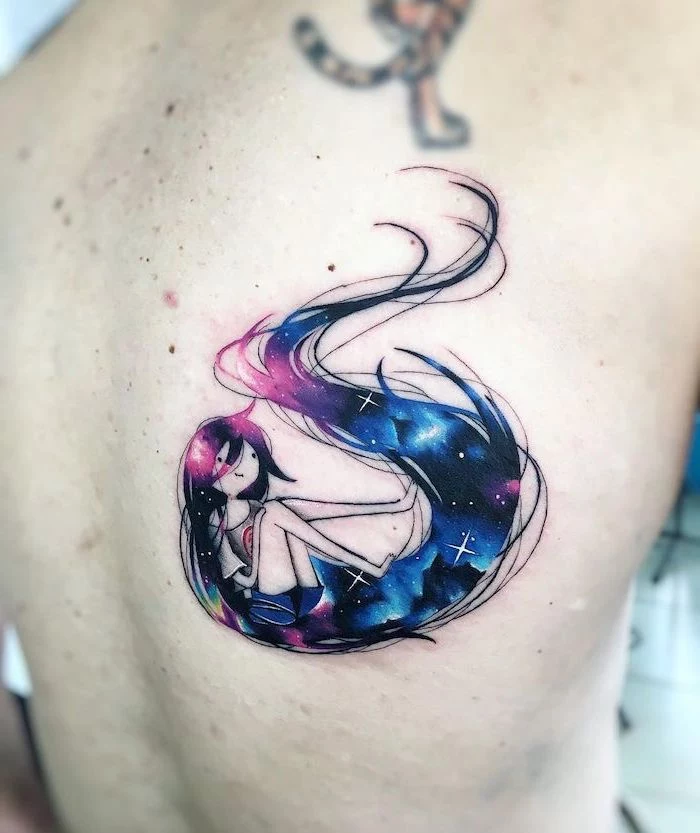
A critical point: The biggest risk with a poorly planned galaxy tattoo is not fading, but becoming a ‘muddy bruise’. Without strong black foundations and intelligent use of negative space (bare skin), the blues, purples, and pinks can blur together over the years, losing all definition and turning into an indistinct blob. Contrast is everything.
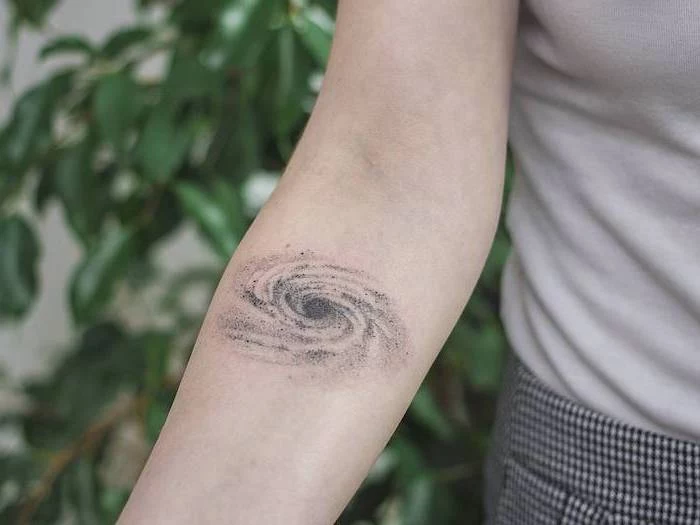
Tired of the classic blue and purple nebula? The universe offers a much wider palette. Consider asking your artist about these themes:
- Golden Nebulae: Using fiery oranges, deep yellows, and rich reds inspired by images from the James Webb Space Telescope.
- Aurora Borealis Sky: A celestial look grounded on Earth, blending vibrant greens, teals, and electric pinks.
- Monochrome Void: A powerful black-and-grey approach using deep blacks, soft grey washes, and stark white ink highlights for a high-contrast, dramatic effect.
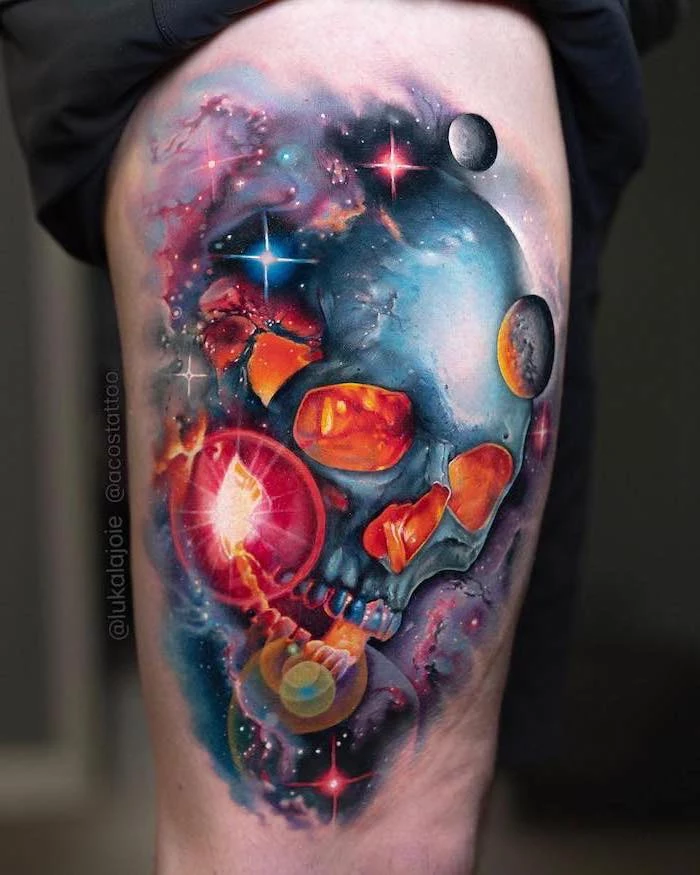
Will the sun really destroy my expensive tattoo?
In a word, yes. UV radiation is the number one enemy of tattoo ink, especially the vibrant pigments used in galaxy tattoos. It breaks down the ink particles within the skin, causing them to fade and lose their intensity over time. Think of a high-quality, broad-spectrum SPF 50+ sunscreen as a non-negotiable part of your tattoo’s long-term care. Apply it generously 15 minutes before any sun exposure.
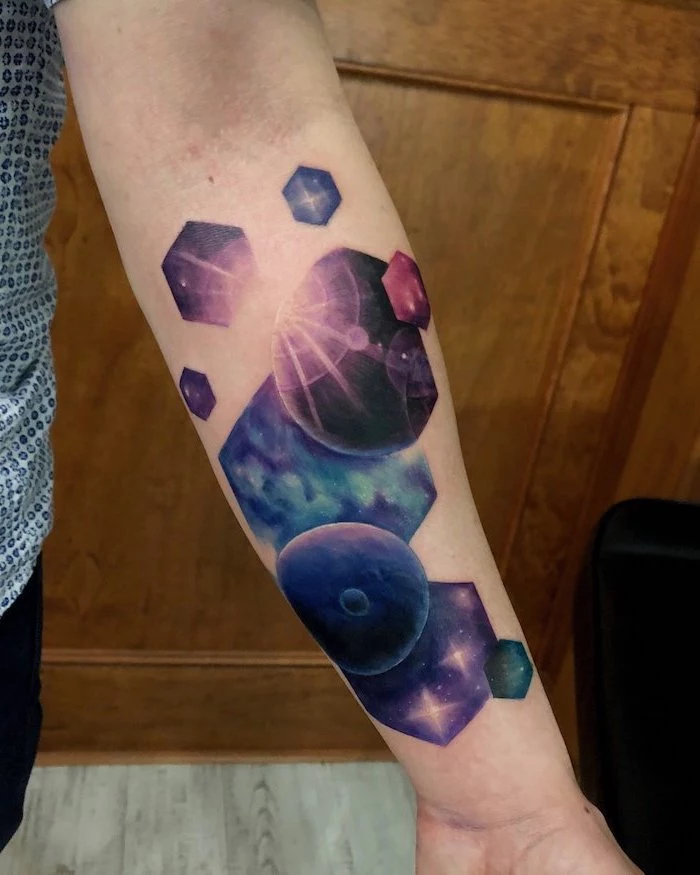
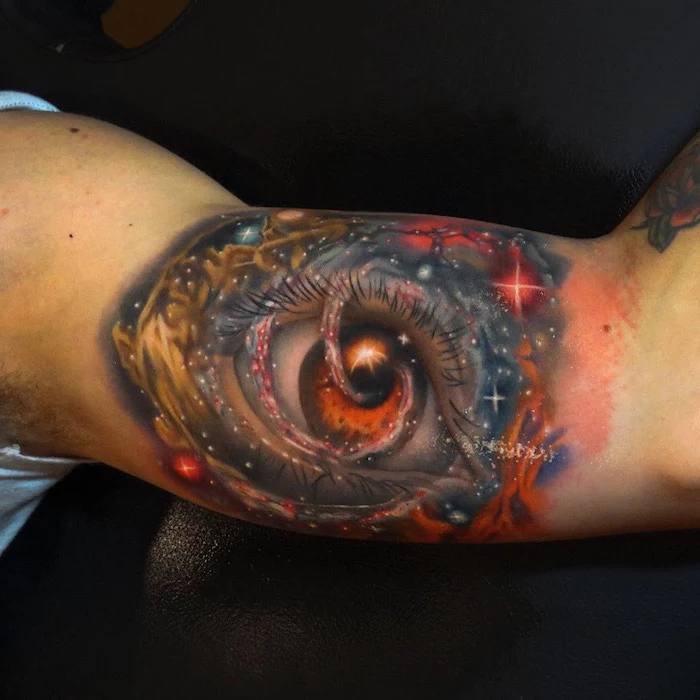
Color Realism: Captures the breathtaking, awe-inspiring beauty of space photography. The goal is vibrancy and depth, making it look like a Hubble picture on your skin. It demands an artist who is a master of color theory and smooth blending.
Black & Grey Realism: Focuses on texture, contrast, and atmosphere. It’s less about color and more about the vast, dramatic emptiness and blinding light of space. This style often ages gracefully, as contrast can hold up longer than some colors.
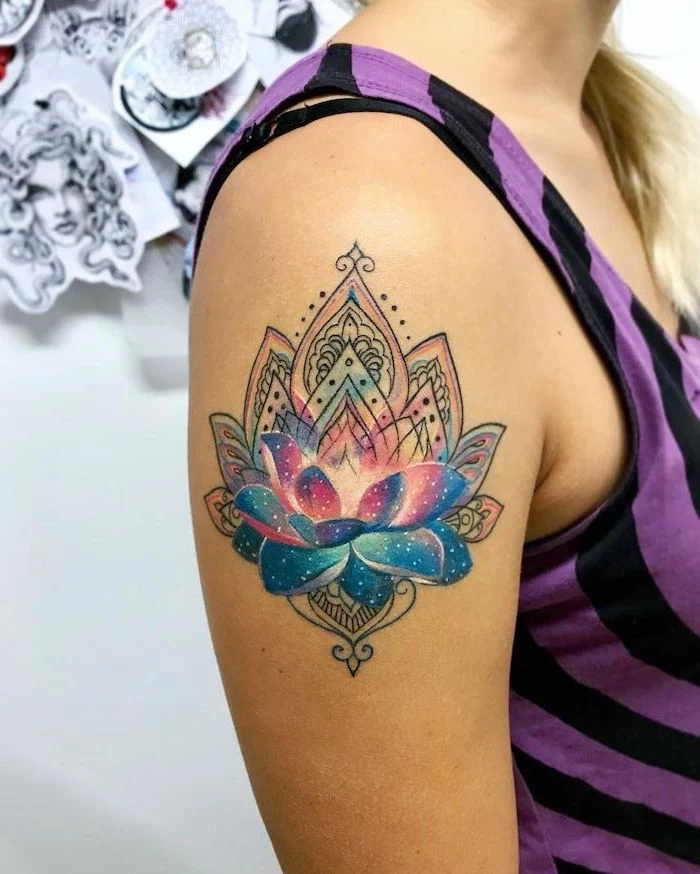
Fact: White ink contains titanium dioxide, which has the largest pigment molecules of any tattoo ink.
This means white ink doesn’t sink as deeply into the skin. It’s perfect for creating brilliant, sharp highlights like twinkling stars or the glare on an astronaut’s helmet. However, it’s prone to fading or yellowing faster than other colors, which is why artists use it strategically for final-pass details, not for filling large areas.
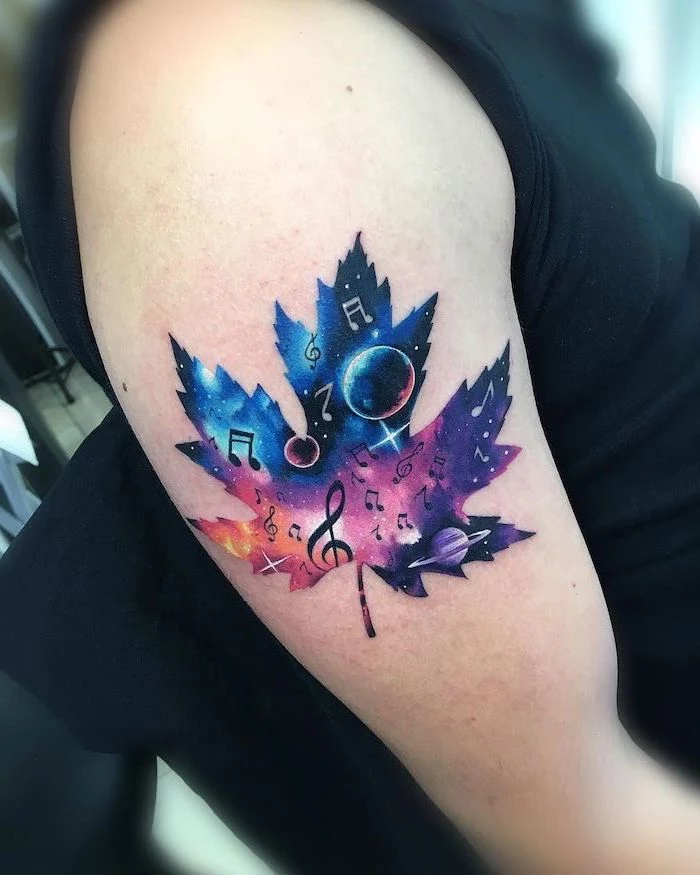
Bringing the right inspiration to your artist is key. Don’t just show them other tattoos. Instead, bring high-resolution source photos from NASA, the ESA, or the James Webb Telescope. Look up specific objects you find beautiful, like the Pillars of Creation in the Eagle Nebula or the vibrant clouds of the Orion Nebula. This gives your artist authentic material to interpret, rather than just copying another artist’s work.

- Crisp, defined planets, not blurry circles.
- Vibrant colors that pop, even after years.
- A composition that flows with the muscles of your arm or leg.
The secret? When choosing an artist, always ask to see photos of their galaxy tattoos that are fully HEALED, at least a year old. A fresh tattoo always looks good; a healed one tells the truth about their skill.
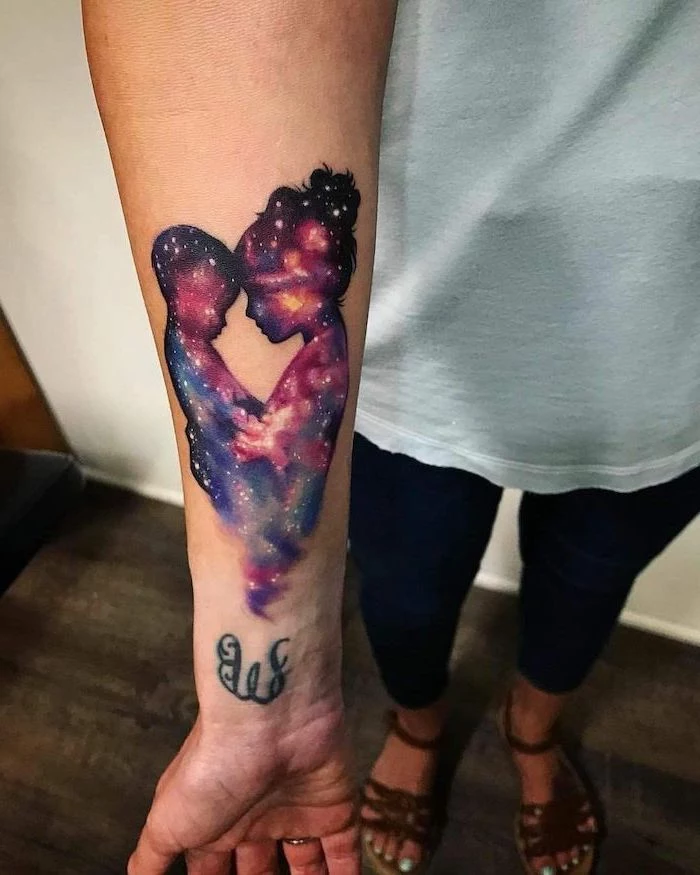
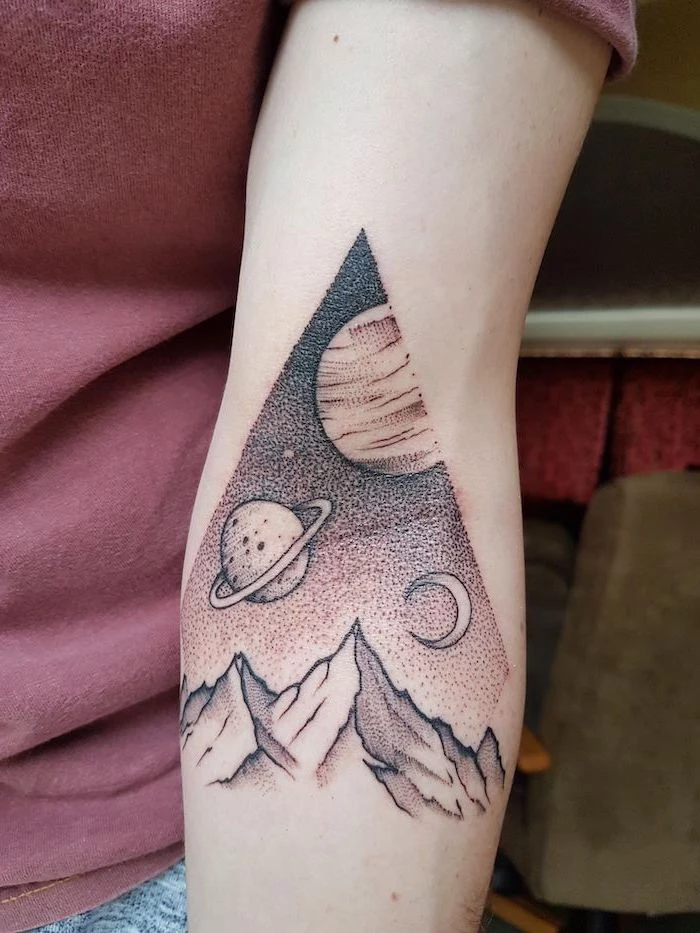
Artist Ink Choices Matter: While you don’t choose the ink, knowing the tools shows you’ve done your research. Many top artists create their cosmic palettes by mixing brands. They might use Dynamic Color Co. Triple Black for the deepest parts of the void because of its legendary darkness and longevity, while using the incredibly vibrant and smooth-blending magentas and cyans from Eternal Ink or World Famous Ink for the nebula clouds.
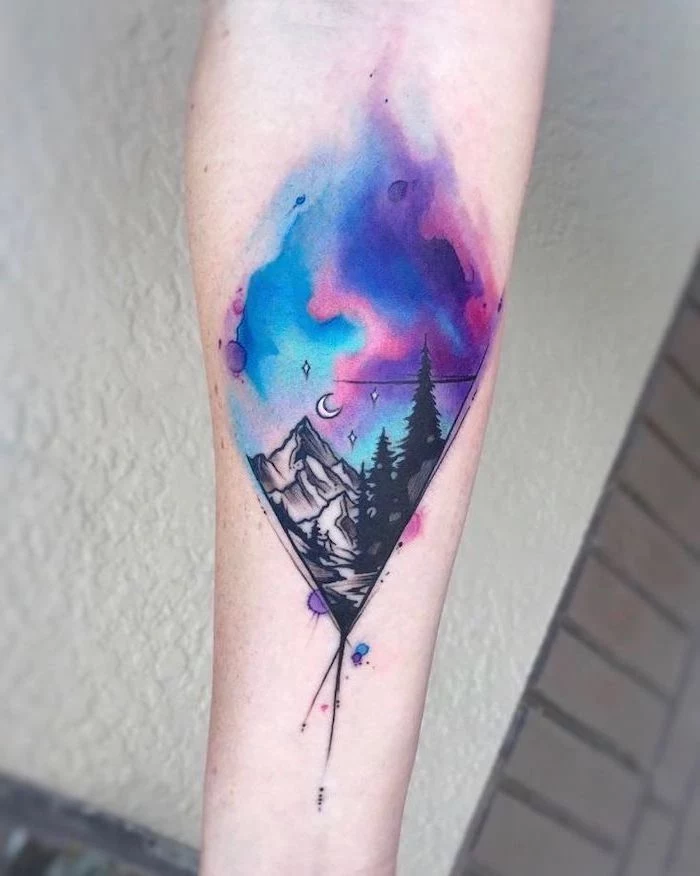
How often will a galaxy tattoo need a touch-up?
If the tattoo is done correctly by a skilled artist and you protect it from the sun, it might never need a mandatory touch-up. The blackwork will hold its structure indefinitely. However, the most brilliant colors—especially yellows, light blues, and pinks—may soften over a decade. A ‘color refresh’ session after 5-10 years can bring back that day-one vibrancy and make the entire piece pop again.
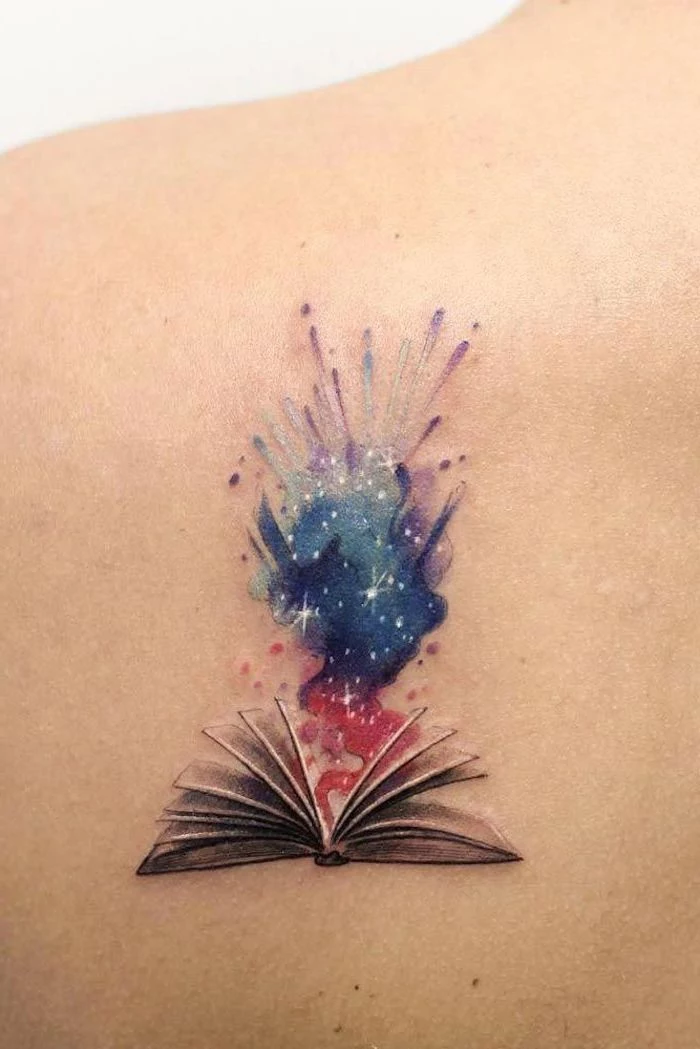
The geometric trend is a perfect match for the cosmic. It creates a stunning contrast between the soft, chaotic nature of a nebula and the hard, predictable order of mathematics. Popular integrations include:
- A honeycomb pattern where each cell contains a different planet or starfield.
- Sacred geometry symbols, like a Flower of Life, overlaid on a galactic background.
- Sharp, abstract triangles or shards that seem to ‘break’ to reveal the universe underneath.
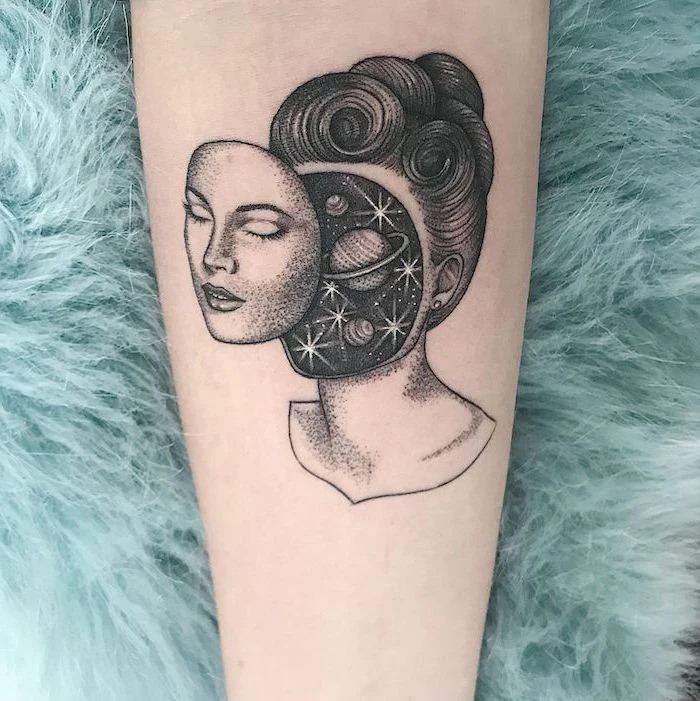
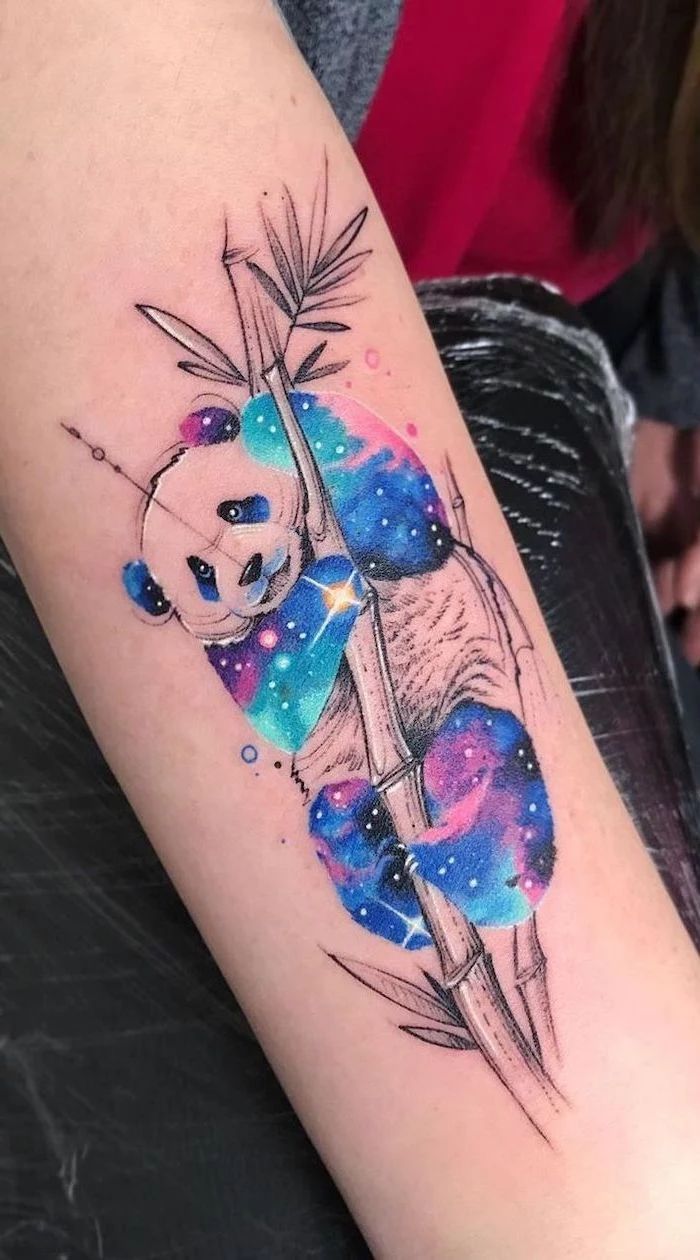
Be prepared for the session itself. A large galaxy piece is a marathon. The dense color packing and blending required mean you’ll be under the needle for many hours, likely spread across multiple appointments. Bring water, sugary snacks to keep your blood sugar up, and headphones or a book. Your physical endurance is part of the process.
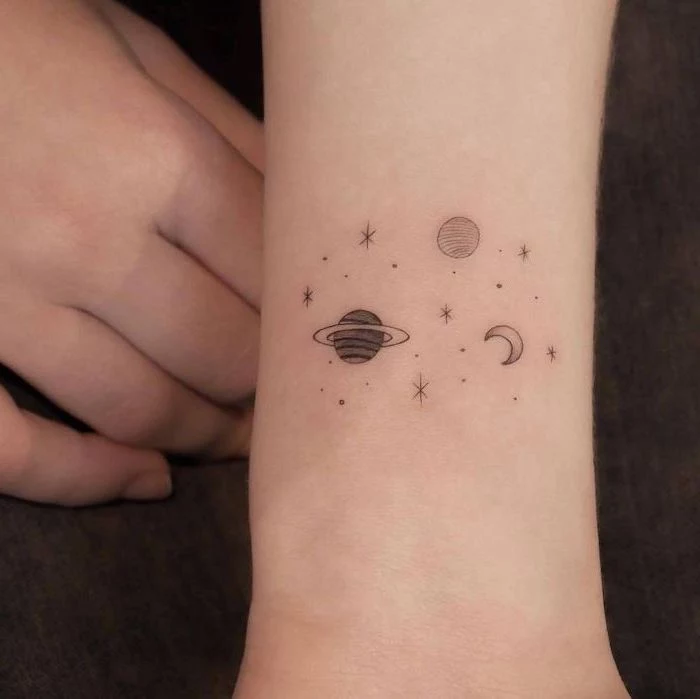
According to a 2019 Dalia Research study, Italy has the highest percentage of tattooed people, with 48% of respondents having at least one tattoo.
This global passion for ink has pushed artistic boundaries, allowing for hyper-specialized styles like cosmic realism to flourish. The demand for unique, large-scale art has given artists the client base needed to dedicate their careers to perfecting these complex techniques.
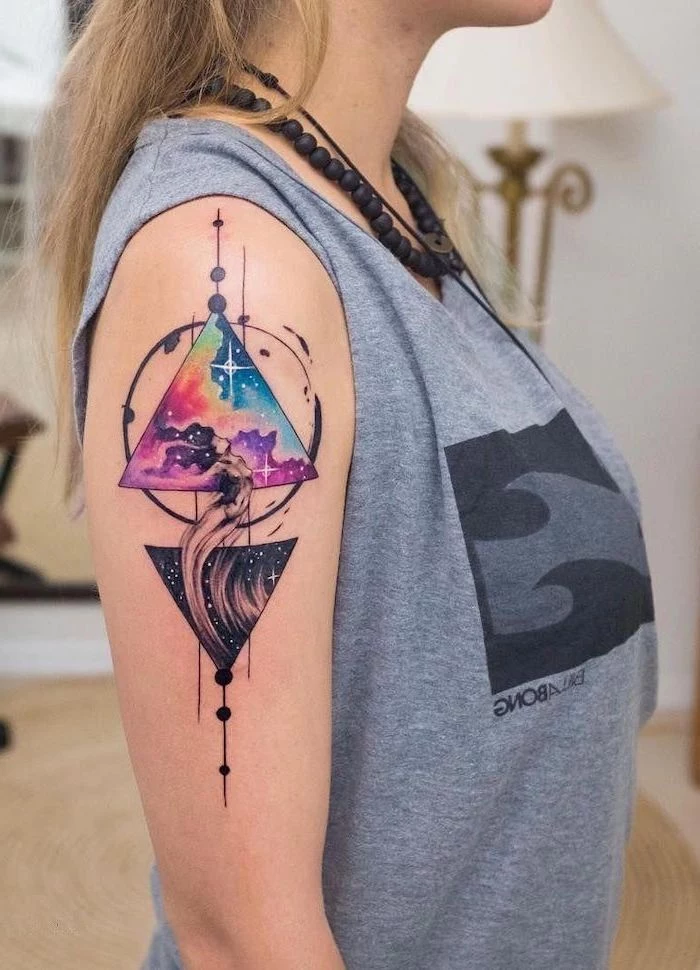
An important financial reality: A well-executed galaxy sleeve or large back piece is a significant financial investment, often costing several thousand dollars and requiring multiple full-day sessions. The skill, time, and materials involved are substantial. This is the pinnacle of tattoo artistry, not a style where you should look for a bargain. Quality costs, and in this case, it’s the difference between a work of art and a future cover-up.
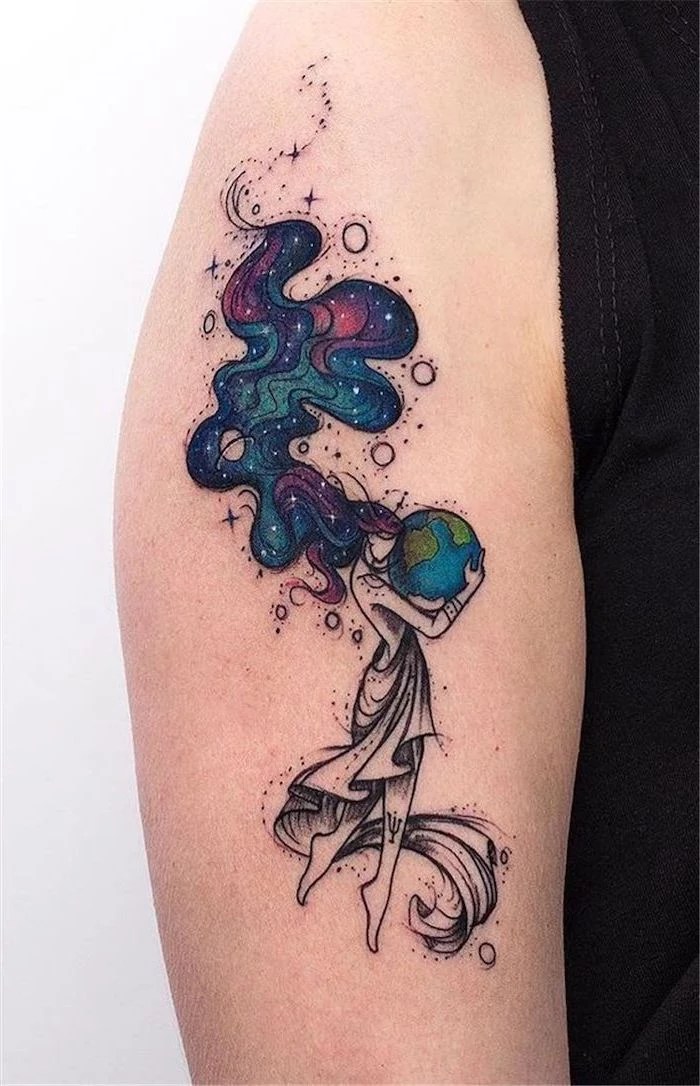
The ‘watercolor’ tattoo style can lend a unique, ethereal feel to a space theme. Instead of crisp realism, it uses soft edges, color gradients that bleed into each other, and intentional ‘splatter’ effects to represent stars and cosmic dust. It creates a more abstract and fluid interpretation of the cosmos, focusing on emotion and movement rather than astronomical accuracy.
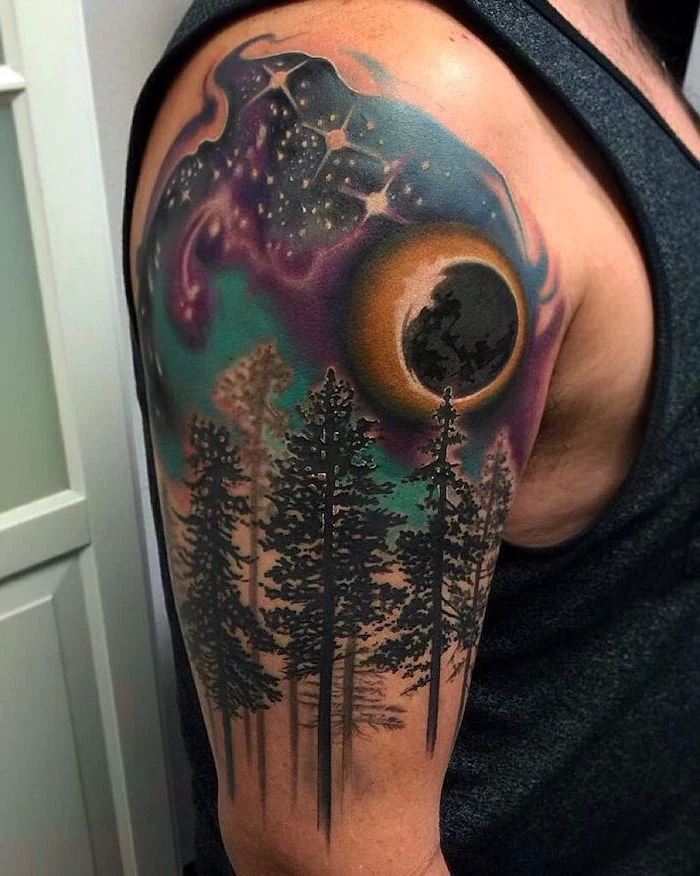
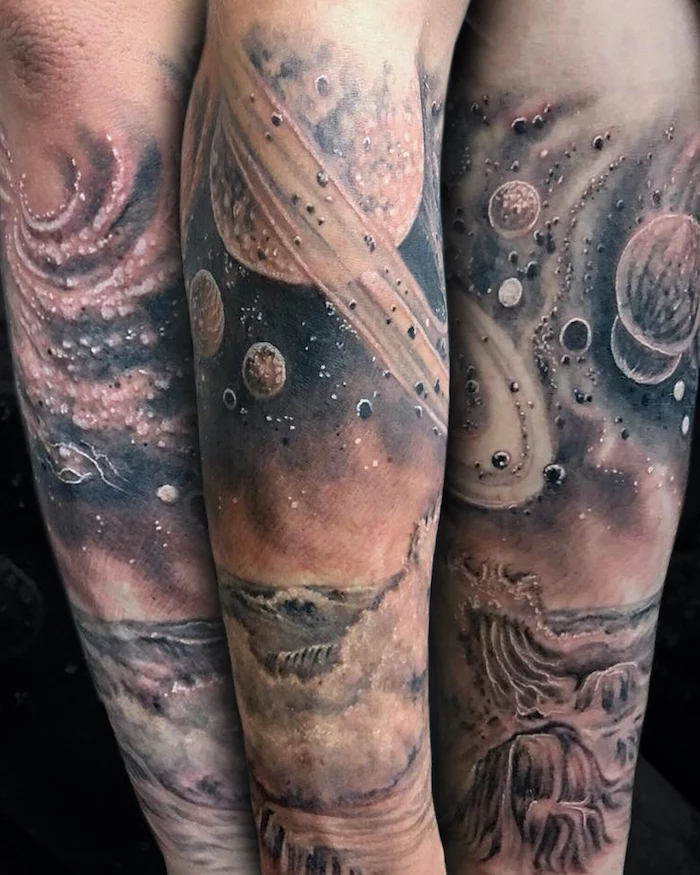
- It connects you to something infinitely larger than yourself.
- It’s a permanent piece of wonder and curiosity.
- It reminds you of the beauty that exists in the dark.
More than just a picture, a galaxy tattoo is wearing a piece of cosmic poetry on your skin.
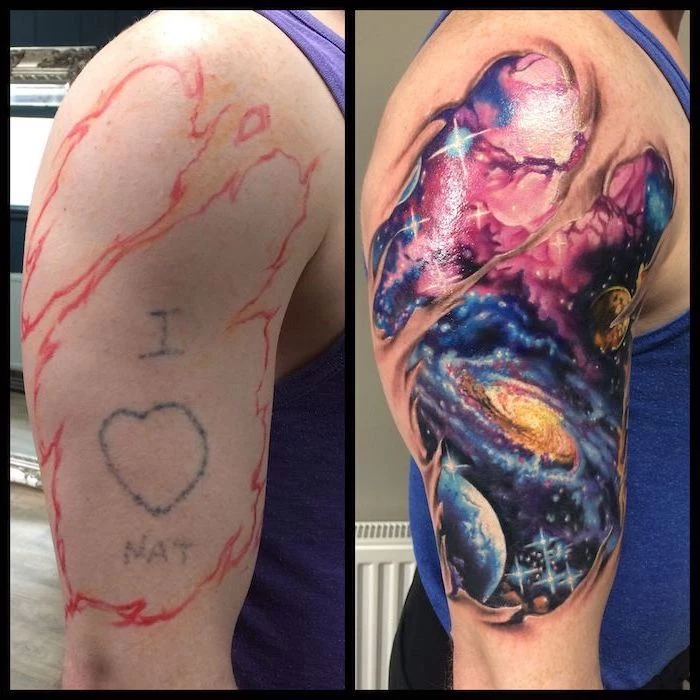
Focal Point vs. Atmosphere. Decide on your design’s philosophy. Is it an Object-focused piece, where a planet, astronaut, or spaceship is the clear hero, and the galaxy serves as the background? Or is it an Atmosphere-focused piece, where the swirling nebula and starfield *are* the subject, creating an immersive, almost abstract experience? Your choice will dictate the entire composition.
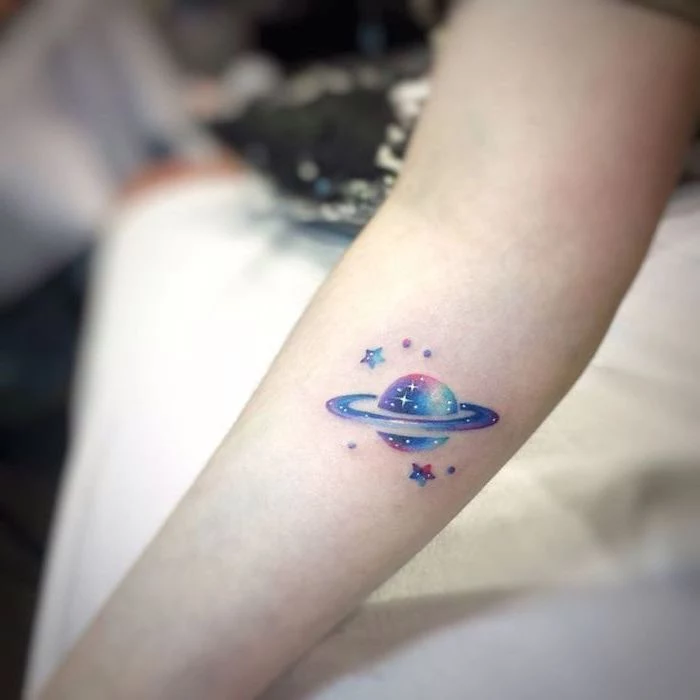
Don’t forget the void: In space, darkness is not empty; it’s what gives the light its meaning. In tattooing, this is called negative space. Leaving areas of untouched skin or solid black is crucial in a galaxy design. It prevents the piece from becoming overly busy, provides visual resting points, and makes the colored elements appear infinitely brighter by contrast.
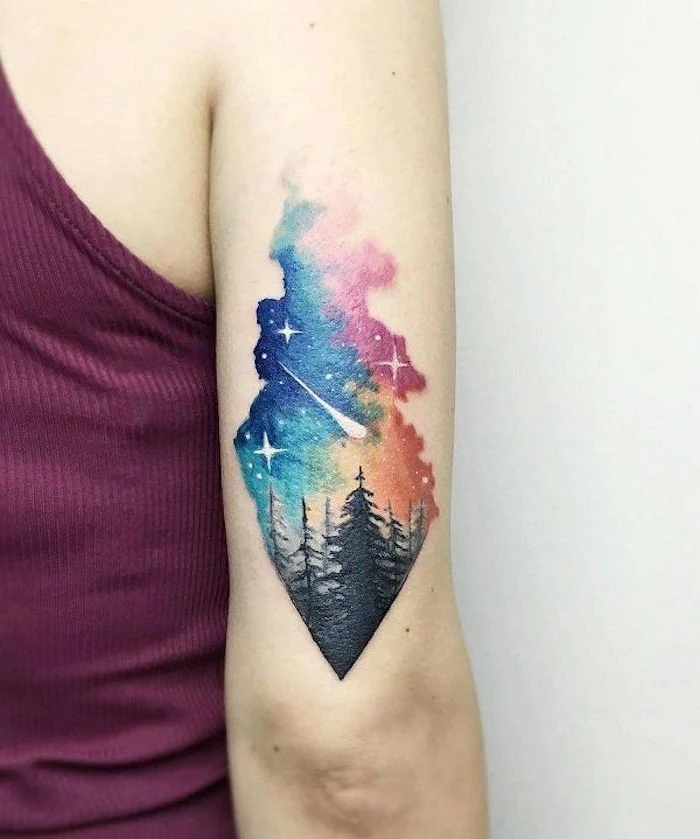
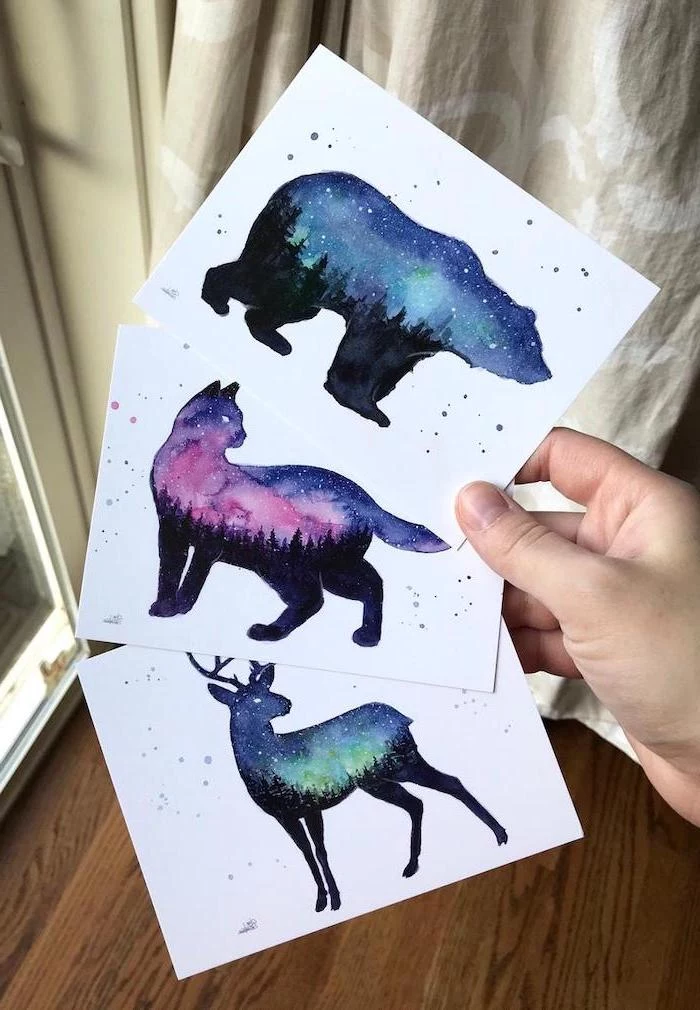
What’s the best placement for a detailed space scene?
Think of your body as a canvas. Large, flatter muscle groups are ideal for expansive galaxy tattoos because they minimize distortion. The outer thigh, the back, and the forearm offer generous, uninterrupted surfaces to build depth and detail. Areas with a lot of movement and bony protrusions, like the elbow, knee, or hands, are challenging and better suited for smaller, isolated cosmic elements rather than a sweeping nebula.
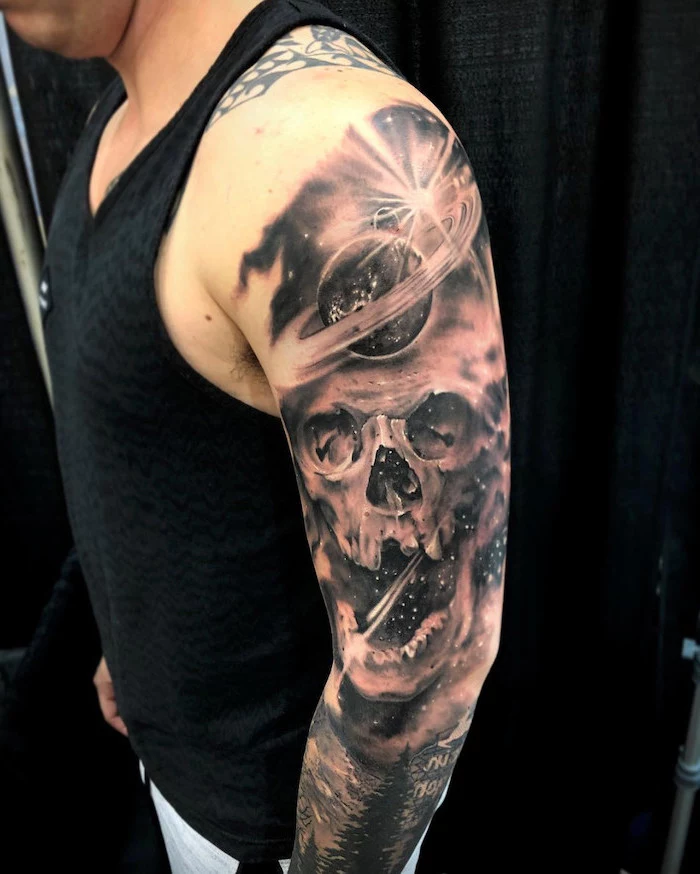
- Packing too many iconic elements (all 8 planets, a rocket, an alien, etc.) into a small space.
- A lack of a clear light source, making the scene look flat.
- Using a low-resolution, pixelated image from the internet as the primary reference.
- Forgetting that the design needs to look good from 10 feet away, not just up close.
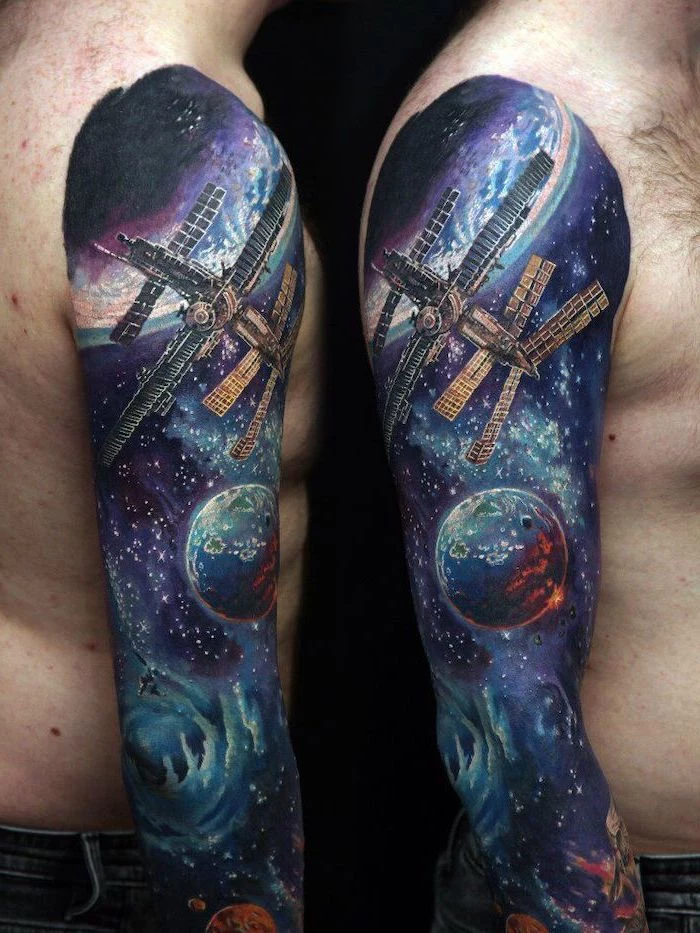
A study published in the ‘Journal of Clinical and Aesthetic Dermatology’ highlights that the longevity of tattoo ink is significantly impacted by the individual’s immune system, as macrophages slowly carry away ink particles over a lifetime.
This biological reality is why a strong initial application is key. An expert artist packs the ink densely and at the correct depth, giving your body more pigment to hold onto for decades to come, ensuring your nebula’s vibrancy fights the slow fade of time.
If a full sleeve feels too daunting, consider a ‘cosmic accent’. This could be a band of nebula wrapping around the forearm, a shard of galaxy appearing to break through the skin on the calf, or having the cosmos integrated into another design. A popular example is a portrait of an animal where its fur transitions into a starfield, blending two passions into one cohesive piece of art.

